A few months ago we did a USB 3.1 Gen1 to 5GbE Network Adapter Guide and one of the most requested items after publishing was a request to test the QNA-UC5G1T. This has sat in the review pipeline, but we finally have a chance to publish our review. We are going to answer the question of whether the QNAP QNA-UC5G1T is a solid USB 3.1 to 5GbE adapter, and what some of the limitations are.
USB 3.1 to 5GbE Video
Update: Since we have this series, we made a video talking about the first three units and what we saw when testing:
You can check out a summary of the three options we tested in that video. As always, we suggest opening the video in its own YouTube tab. This video will help provide the background for this review.
QNAP QNA-UC5G1T Hardware Overview
The QNAP QNA-UC5G1T adapter is a relatively simple unit.
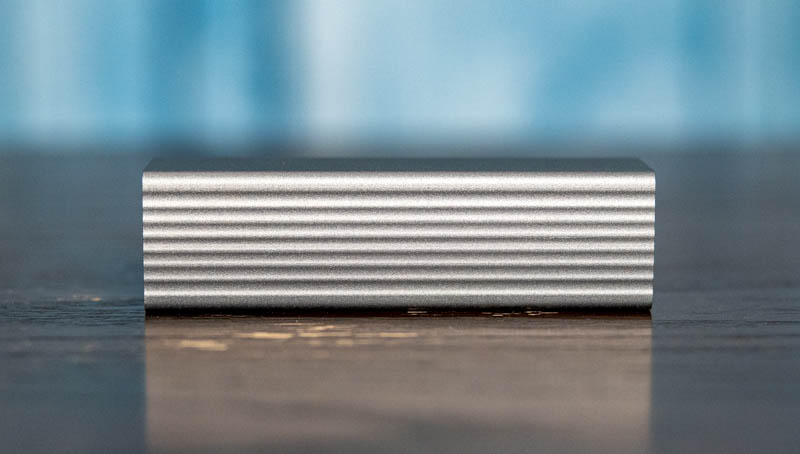
Since this did not get the video treatment of the other units, we have a version lit with colored lights:
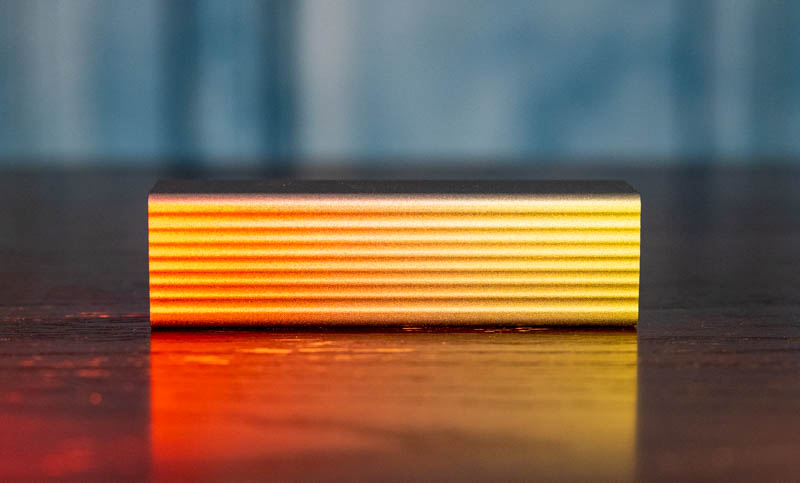
Overall, this is not the most exciting unit, but it is mostly metal which is nice from a durability perspective.
On one end we get a 5GBase-T port which one connects RJ45 cabling to.,
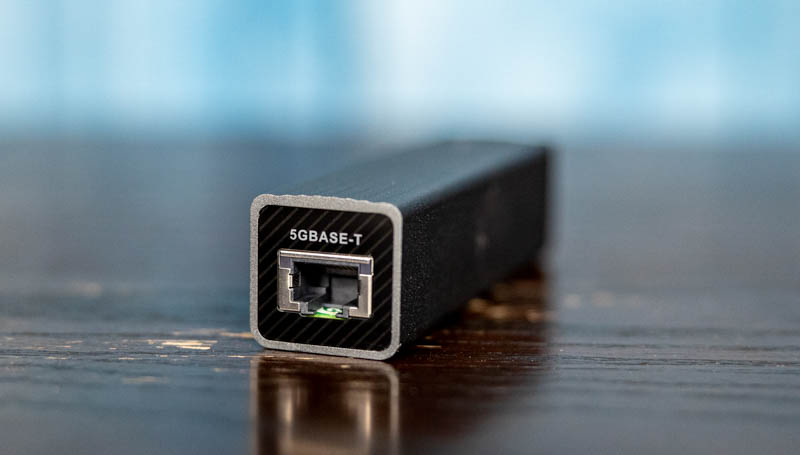
On the other end, we get a USB Type-C port. Effectively we have a large metal chassis with the network on one end and USB on the other.
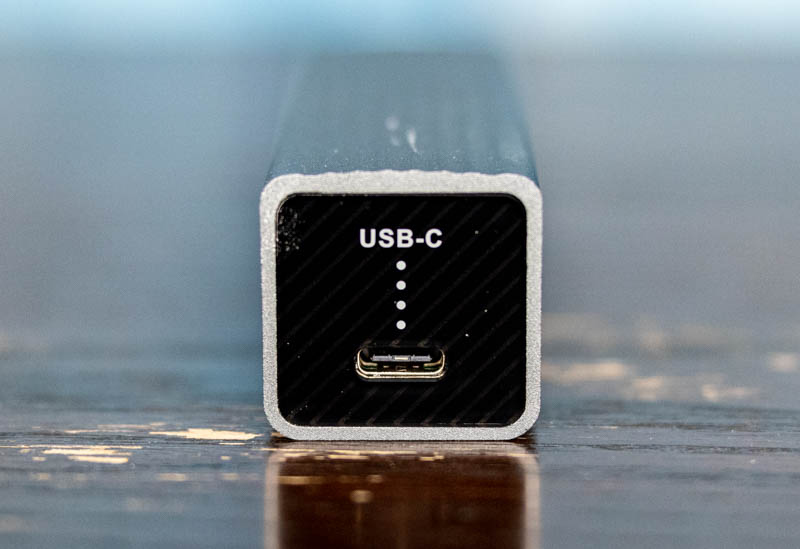
A nice feature is that QNAP also includes a USB Type-C to Type-A cable with this unit. That may not seem like a big deal, but it makes the unit more flexible than if it had a fixed cable. If you do not need this because you are using Type-C to Type-C, then there is still a good chance this can be put to use for another reason.
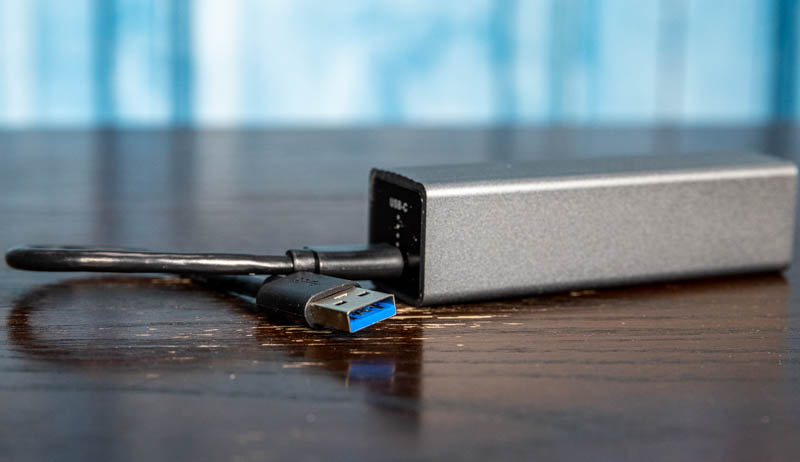
In the 5GbE class, the cost is higher than the 2.5GbE generation so we prefer having a metal chassis that QNAP delivers on. This unit also has better cooling than many.
QNAPQNA-UC5G1TUSB to 5GbE Network Adapter Setup
Even though the NIC uses the Aquantia AQC111U which is now a Marvell offering, QNAP is not just allowing this to be a generic card. Our test systems did not work out of the box on Windows 10 so we had to install drivers. You can see below that the unit shows up as a QNAP QNA-UC5G1T instead of a generic Aquantia device.
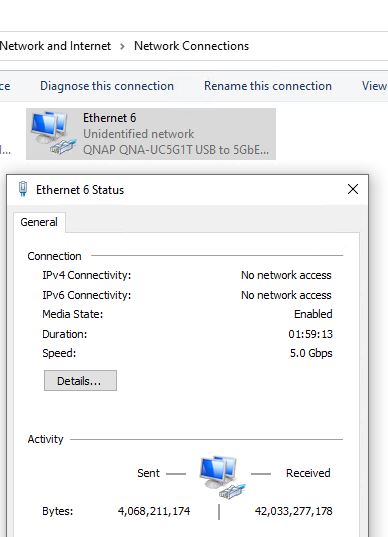
Once we got the NIC installed, everything worked as expected. Still, this is not the best user experience. There are a number of features such as VLAN tagging and Jumbo Frames that one may want to change after setting up the NIC in the standard network adapter configuration, but everything was where we expected.
One item that we did not experience, but we heard feedback that others have, is with VLAN tagging and enforcement. We are simply going to note that others have had this challenge, so if this is an important feature to you, take that into consideration. You can, tag at the switch but it can be preferable to do so at the NIC.
QNAP QNA-UC5G1T USB 5GbE NIC Performance
The performance was, what we would expect now that this is the fourth adapter in our review series. Still, we recognize that this may be different than a normal consumer may expect. We tried this in a number of different configurations including TinyMiniMicro nodes from Dell, HPE, and Lenovo. We tried ThreadRipper based systems, Core i9 systems. We tried USB 3.1 Gen1 and Gen2 ports. We tried going through Netgear and MikroTik switches. We also tried multiple targets. The results remained fairly consistent. Our iperf3 results topped out around 3.44-3.45Gbps. This is common for these solutions.
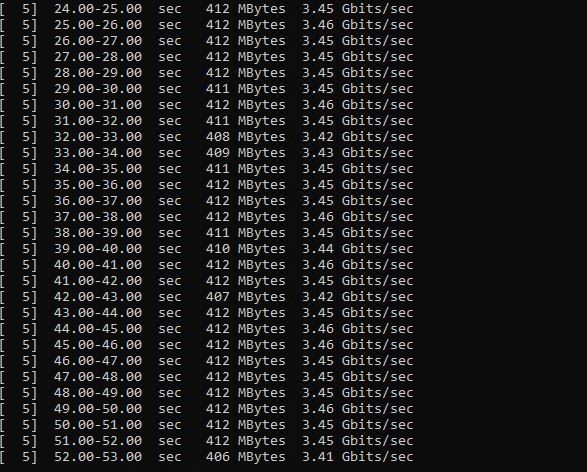
Something that we have seen before is that adding Jumbo Frames actually meant we had slightly worse performance.
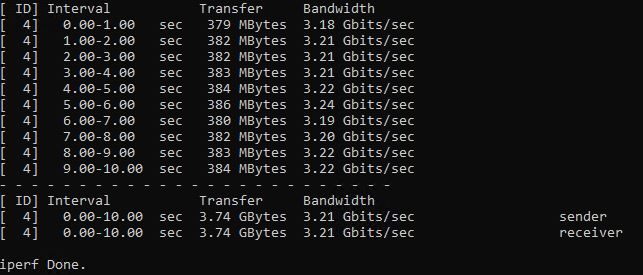
Here is the adapter utilization while running these tests since that is a point readers wanted to see:
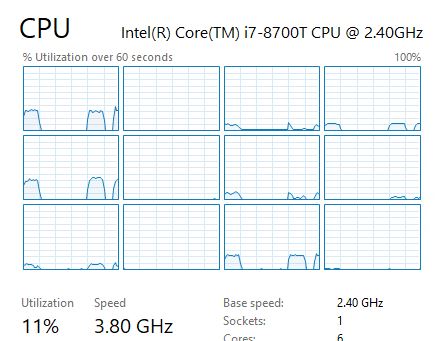
We saw slightly higher CPU utilization with this unit versus some other units with 11% here instead of 9% with the StarTech and 10% with the Sabrent. Our test system for this screenshot was hitting clocks of 3.80GHz which was the same as the Sabrent. For comparison, the TRENDnet unit which used its own drivers from 2019 was around 17% here so QNAP is a bit ahead.
The big question for many is why we have a 5GbE adapter that is only delivering 3.2-3.5Gbps of performance. This seems to be a USB 3.1 Gen1 adapter only, not a Gen2 device. We tried on over a dozen different systems and this only linked at USB 3.1 Gen1 speeds. We have some that suggested that we may not have had enough test system diversity even using over a dozen different systems on different platforms and vendors, however here is the block diagram for the AQC111U which shows it only has a USB 3.1 Gen1 PHY:
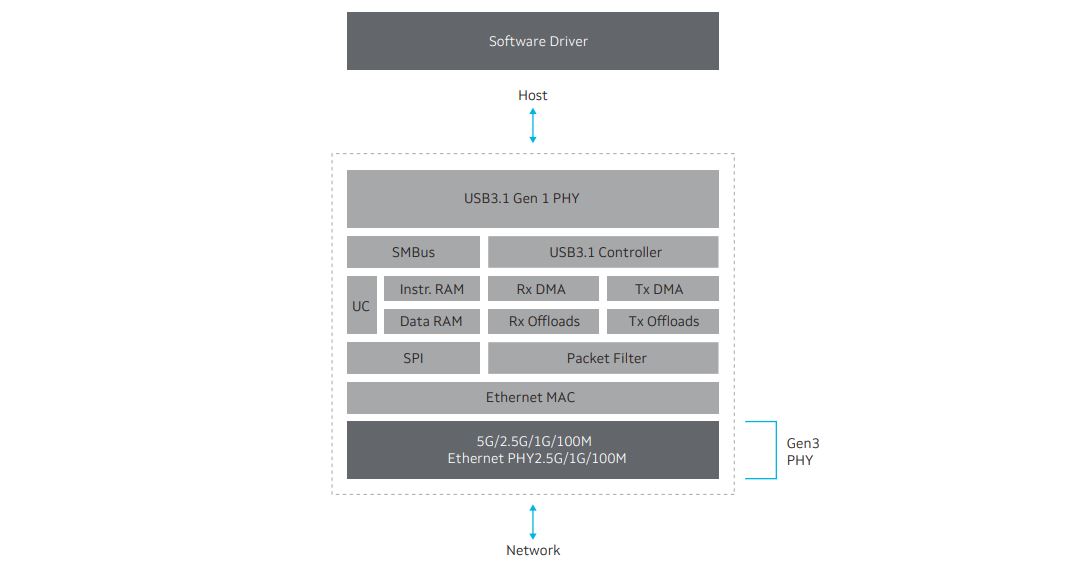
Practically, the overhead from a USB link that is only running at 5Gbps itself means that we are limited to the performance range we are seeing.
For a normal consumer, this means that although the NIC is capable of 5Gbps links to the network, it can only deliver around 3.2-3.5Gbps to the host USB system. We expect that now after testing a number of these adapters, but someone that has not read this review will not know this is the case.
Final Words
Overall, we saw better performance than the TRENDnet unit, and close to the StarTech and Sabrent units from the QNAP adapter. Given that these adapters generally use the same network controller and USB host interface, performance is about what we would expect.

What the QNAP QNA-UC5G1T offers is metal housing and flexible cabling, both of which are top-tier in terms of the units we have tested. From that standpoint, we have a very good mix of physical attributes and the same chip we have seen in other adapters of this class.
Something we do not like is that the performance is around 30% lower than a consumer that has not read our reviews may expect. Many of our readers know why this delta exists just from USB overheads, but it is still a challenge for all of these adapters trying to gain the trust of customers. It will be up to our readers to decide if adding ~1Gbps is worth paying twice what we see many 2.5GbE adapters sell for. The limitations of Gen1 USB 3 make this a much less clear picture than it would be if these were Gen2 devices.
In terms of pricing, at around $79 street pricing. This was less than the StarTech and TRENDnet units, but also around 33% more than the Sabrent unit. Given that this is a robust/ flexible physical design, we think that we would recommend this over the StarTech and TRENDnet units, but if the Sabrent unit is less expensive we would probably recommend that instead. The TRENDnet unit has fallen in price to be a few dollars cheaper than this since we purchased these units, but given the issues we had with the TRENDnet version, we would recommend this over the TRENDnet. Overall, this is a good unit, so our recommendation is largely based on price.

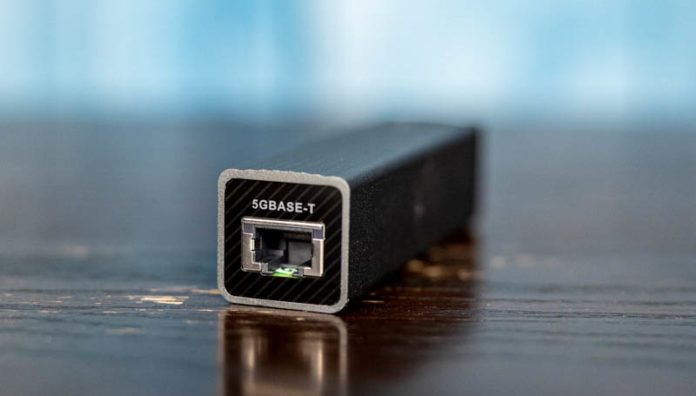

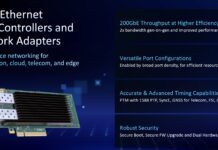
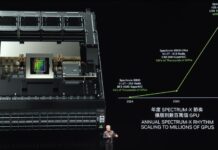
Regarding that pesky Gen1 limitation:
Are there any chips that don’t share that weakness and thus can deliver true 5Gb or more?
Availability and pricing of these parts is insane, for example the sabrent 5GbE model isn’t available at all, and the 2.5GbE is selling for 2x MSRP. What the hell is going on?
@Ollster As far as I can tell the AQC111U is the only USB to 5Gb chip out there. I would assume Realtek will come out with one at some point.
Honestly this should be called out as false advertising since it’s impossible to reach 5Gbps of throughput over USB 3.0.
@Pete Mitchell: I’d be curious if vendors don’t want to delve into the user confusion of USB 3 gen1 vs. gen2 ports for what is a slightly niche product(pretty much only laptops or USFFs that can’t accept a PCIe expansion); or if demand is being damped by the fact that 1GbE NICs are effectively free; while people who actually want to spend money have more options in 10GbE thunderbolt.
Maybe run iperf with the parallel flag?
-p 4
Is a good place to start.
As always a very fair and honest review. Thanks for making it easier for consumers to choose the USB 5Gb adapters.
I’ve connected one of my QNAP 5Gb adapters to a USB 3 port and experienced exactly the performance in your test. Thanks for the confirmation.
I’ve connected one of my QNAP 5Gb adapters to a “USB C” port on my NAS (2 each 2.5Gb & 1 each 10Gb ports + 1 each USB C & multiple USB 3). I haven’t checked the actually transfer speed of the USB C port with this device. I just assumed that it would use the USB C port to it’s max. Interesting, I’ll have to check that.
Thanks again
@Pete Mitchell
You are entirely right. The descriptions/marketing for these products are simply alternative facts. The AQC111U is USB 3 Gen 1. It will never reach 4.75Gbits/sec.
The picture lit with color is a nice touch (in place of a video). And that’s what makes your reviews fun.
From STH, I’d like to see some discussion of which Linux flavors support the Aquantia kernel drivers (i.e. can we get this to work in some flavors of Linux so that it doesn’t fail each time we update the kernel).
Like I have already commented on the Sabrent review: The AQC111U chips seems to have been discontinued after the Marvell takeover and drivers (for all OS) are not maintained since 2019. Top level searches on the Marvell site won’t find the product any more, and only search engines will still dig out deep references to older documents.
That may be fine with Windows, where older binary drivers have sometimes worked for a decade, but on Linux (current CentOS7 and CentOS8 tried) the source code drivers won’t compile any more.
That warning needs to be highlighted in your reviews: the current drop in prices is to clear the inventory of a product that is obsolete.
There seems to be a generic Aquantia upstream driver included in recent Linux (also backported to CentOS7/8), but that needs to recognize the devices and QNAP/Sabrent etc. seem to use device IDs that are sometimes aren’t in the USB device database. E.g. my QNAP variant failed to be recognized after a CentOS8 update around the end of the year (had to revert to an older kernel to get it back), while the Sabrent never worked with distro driver and any attempt to compile the Aquantia source code driver failed.
With the RealTek 2.5GBit USB3 NICs I did manage to patch the source code to get it to compile, but it’s not integrated in DKMS and a manual process on every kernel update. That one also has a generic driver in Linux (cdc_ncm), but that’s very shaky and produces tons of log messages.
Adding their IDs to the USB database may help you, but that’s not quite the out-of-the-box experience some potential purchases would be ready to face.
You might have also measured and mentioned the power consumption of these devices. While 5GBit Ethernet doesn’t sound like a mobile use case anyway, you might not be aware that without a power supply connected, these adapters will suck your ultrabook dry in less than 15 minutes: there is a reason for these metal cases and cooling fins (on the Sabrent).
After all these driver issues, also with the 2.5Gbit RealTek USB3 NICs, I have finally resorted to the TB3/ACQ107 adapters from Sabrent, which are pretty much at the same price point of where the QNAP used to be, but deliver 1.1GByte/s throughput and are quite literally undistinguishable from a “normal” form-factor PCIe x4 NIC to all operating systems and their drivers. And yes, these suck even more Watts.
But those chips are at least still supported by Marvell.
@Dumdum: In my experience the “-P4” flag only tends to help with Windows (but never enough to reach Linux performance levels). On Linux systems there is hardly any difference, unless the hardware is too weak.
For fun I just tested both, the RealTek 2.5GBit adapter and the QNAP 5GBit NIC on a Raspberry PI 4. 2.5GBit on a PI4 translate to 1.5GBit/s (180MByte/s) with iperf3 on a single connection, but drop to 1GBit/s (180MByte/s) with four (even if the PI has a quad core CPU).
The QNAP will deliver 2GBit/s (245MByte/s) with a single connection and drops somewhat less with -P4 (240MByte/s) or P2.
Quite clearly the code (or DMA) that moves the data isn’t a bottleneck in Linux and parallel connections just require more computational overhead for the CPU to manage.
Consider this also, from someone who used to do some systems programming.
There is the USB host at one end, a dongle in the middle, and an ethernet host at the other end.
The programming logic in the dongle may not use any “double-buffering” or other proven techniques for enhancing parallelism.
Therefore, after the USB host has sent a packet to the dongle, that USB host needs to wait for the dongle to forward that packet to the ethernet host at the other end of this “chain”.
Once the ethernet host has acknowledged to the dongle receipt of that packet, then the dongle can turn around and accept another packet from the USB host.
And so on.
What may be advertised as “full duplex”, “double buffering” etc. may, in fact, be a serial chain of events that results in accumulated WAIT times that are simply unavoidable, from a programmer’s point of view.
When a dongle is transmitting to the ethernet host, is the dongle smart enough to be receiving from the USB host AT THE SAME TIME? I doubt it, given the throughput numbers consistently reported in these reviews:
“3.44-3.45Gbps” may be the very best that can ever be expected, when all of the relevant factors are taken into consideration.
The Aquantia chipset devices (Qnap and Sabrent) seem lag behind the Realtek devices when connecting at 2.5Gbe. 200Mb/s vs 260Mb/s.
I have the same issue on the QNAP Adapter that you observed with the TrendNet 5GBit USB Adapter. I get random disconnects in the network connection it seems the adapter drops the connection..the adapter is still in the device manager and not disappearing but the network.
It happens randomly. I changes cables, router, invested 1000€ to change and test ..today I stumbled over your article on the Trendnet one ..